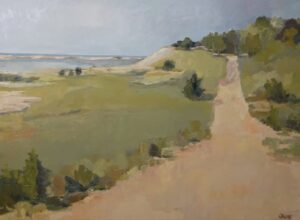An exhibition currently on view in Orleans combines works from two galleries: Orleans Modern Art and Garvey Rita Art & Antiques. Titled “Side by Side,” the show draws aesthetic connections across different time periods and styles. In doing so, it establishes new dialogues between works in each gallery’s collection and deepens one’s appreciation of each individual painting.

Paintings are paired and otherwise grouped in the show according to similarities — and distinctive differences. One pairing is Cape Cod Dunes by Robert Douglas Hunter with High Head, Truro by Kathleen Dunn Jacobs. Both oil paintings on canvas capture views of dunes in the Cape Cod landscape. But Jacobs’s work, which is nearly twice the size of Hunter’s, is marked by wider brushstrokes that maintain a sense of abstraction througout the image. Hunter’s application of paint is sharper and more precise, with detailed strokes visible in the dense shadows of bushes in the foreground.

While both artists use faded blues for the skies in the backgrounds of their images, Hunter’s palette extends into deeper shades of maroon, and his flat shapes contrast with the way Jacobs’s looser style brings movement and energy to her work. Yet each artist — Hunter with his sharp brushstrokes and Jacobs with her more emphatic gestures — manages to capture something of the breezy atmosphere of the dunes.
Another grouping features work by three artists united by their depictions of water on cloudy, gray days: Julia Felsenthal, Agnes Weinrich, and the late Provincetown painter Pat de Groot. There’s a particularly marked contrast between the work of De Groot, who was known for her stark, minimalist seascapes, and Felsenthal’s more physical depiction of water, which ripples like pulsing veins, its waves active and ominous.

One grouping pairs works by Colin Alexander Scott and Mabel May Woodward. Woodward, who taught at the Rhode Island School of Design, captures a busy summer day of boats on the harbor in her oil on cardboard painting Provincetown Birds Eye View. Light bounces off the sides of white houses in the jumbled fishing village. Meanwhile, Scott’s Provincetown Harbor brings the viewer closer to those sailboats that Woodward painted from the hills overlooking the harbor; his use of white and teal to depict the reflection of light on the waves brings a sense of movement and activity to the scene.
Works by the late artists Wolf Kahn, Karl Knaths, and John Robinson Frazier are grouped with a painting by contemporary artist Eric Aho. Knaths, who lived and worked in Provincetown, had a distinct style marked by bold lines, unfinished planes of color, and sharp-edged shapes. But his piece in this grouping seems to stand apart from his more familiar work: it’s less geometric, the lines not as bold and definitive. Similarly, Kahn’s painting isn’t as vibrant and hypnotic in color as some viewers might expect.
Does this grouping emphasize moments of restraint by artists known for bolder visual effects? Even Aho’s painting has a quiet quality to it, as does Frazier’s. In bringing the four together — as it does with the other groupings — the show emphasizes qualities in each artist’s work that might otherwise be overlooked.
Unusual Pairings
The event: Paintings from the collections of Orleans Modern Art and Garvey Rita Art & Antiques
The time: Through Sunday, Dec. 29
The place: Orleans Modern Art, 85 Rt. 6A, Orleans
The cost: Free; see orleansmodern.com for information



